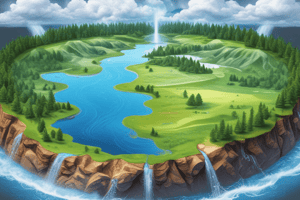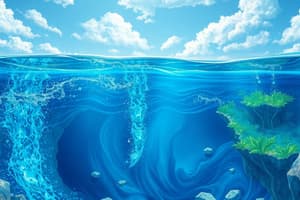Podcast
Questions and Answers
What percentage of the world's land surface is covered by wetlands?
What percentage of the world's land surface is covered by wetlands?
- 4%
- 6% (correct)
- 12%
- 10%
Which of the following is a key role of wetlands?
Which of the following is a key role of wetlands?
- Supporting ecosystems (correct)
- Increasing surface water availability
- Reducing groundwater levels
- Producing potable water
What portion of the water taken from groundwater is used for farming in arid and semi-arid climates?
What portion of the water taken from groundwater is used for farming in arid and semi-arid climates?
- 20%
- 80%
- 60% (correct)
- 40%
Which regions are known to have large aquifers of non-renewable water?
Which regions are known to have large aquifers of non-renewable water?
What percentage of liquid fresh water is found underground?
What percentage of liquid fresh water is found underground?
Which of the following best describes how renewable groundwater can be utilized?
Which of the following best describes how renewable groundwater can be utilized?
What is a characteristic of groundwater that is considered non-renewable?
What is a characteristic of groundwater that is considered non-renewable?
What is a common issue with water quality measurement in many countries?
What is a common issue with water quality measurement in many countries?
What is the primary state of most of Earth's freshwater?
What is the primary state of most of Earth's freshwater?
Out of the total amount of water on Earth, what fraction is considered freshwater?
Out of the total amount of water on Earth, what fraction is considered freshwater?
What percentage of Earth's surface is covered by water?
What percentage of Earth's surface is covered by water?
What is the most significant source of liquid freshwater on Earth?
What is the most significant source of liquid freshwater on Earth?
Which process describes the movement of water from the Earth to the atmosphere?
Which process describes the movement of water from the Earth to the atmosphere?
Which of the following statements best describes the distribution of freshwater?
Which of the following statements best describes the distribution of freshwater?
How does water contribute to life on Earth?
How does water contribute to life on Earth?
What percentage of Earth's freshwater exists in the atmosphere?
What percentage of Earth's freshwater exists in the atmosphere?
What cycle describes the movement of water in the environment?
What cycle describes the movement of water in the environment?
Which process is not a principal component of the water cycle?
Which process is not a principal component of the water cycle?
What is 'green water' primarily used for?
What is 'green water' primarily used for?
In which climate does a lower proportion of precipitation replenish groundwater?
In which climate does a lower proportion of precipitation replenish groundwater?
Approximately how much precipitation returns to the atmosphere in temperate climates?
Approximately how much precipitation returns to the atmosphere in temperate climates?
What role does soil moisture play in water system management?
What role does soil moisture play in water system management?
Which statement about satellite data in soil moisture measurement is true?
Which statement about satellite data in soil moisture measurement is true?
What is the relationship between precipitation and climate?
What is the relationship between precipitation and climate?
What is the primary purpose of coagulation in the raw water treatment process?
What is the primary purpose of coagulation in the raw water treatment process?
Which compound is commonly used as a coagulant in the coagulation process?
Which compound is commonly used as a coagulant in the coagulation process?
What role does flocculation play in the water treatment process?
What role does flocculation play in the water treatment process?
What is sedimentation primarily used for in the treatment of potable water?
What is sedimentation primarily used for in the treatment of potable water?
What is the first step typically involved in many water treatment processes?
What is the first step typically involved in many water treatment processes?
How does zeta potential relate to the coagulation process?
How does zeta potential relate to the coagulation process?
Which processes follow coagulation in the drinking water treatment process?
Which processes follow coagulation in the drinking water treatment process?
Why is monitoring of water resources important in developed countries?
Why is monitoring of water resources important in developed countries?
What is the primary purpose of filtration in water treatment?
What is the primary purpose of filtration in water treatment?
Which method is used to ensure that disease-causing microorganisms are destroyed in water treatment?
Which method is used to ensure that disease-causing microorganisms are destroyed in water treatment?
What is the role of chlorine in the water treatment process?
What is the role of chlorine in the water treatment process?
What is sludge drying in the context of water treatment?
What is sludge drying in the context of water treatment?
How does fluoridation benefit public health?
How does fluoridation benefit public health?
What environmental concern relates to farming activities that impact water sources?
What environmental concern relates to farming activities that impact water sources?
What is a consequence of acid rain on water resources?
What is a consequence of acid rain on water resources?
What is one of the potential impacts of climate change on water resources?
What is one of the potential impacts of climate change on water resources?
Flashcards are hidden until you start studying
Study Notes
Water Distribution and Properties
- Water is essential for life on Earth, covering 71% of the planet's surface.
- 97.5% of Earth's water is saltwater found in oceans.
- Only 2.5% is freshwater, with the majority frozen in glaciers and ice sheets.
- 0.4% of Earth's water is easily accessible freshwater, primarily found underground as groundwater and in lakes, rivers, and streams.
The Water Cycle
- The global water cycle moves water between the atmosphere and Earth through precipitation, infiltration, runoff, groundwater discharge, and evapotranspiration.
- "Blue water" refers to water in rivers, lakes, and aquifers, while "green water" is the water consumed by plants and subsequently released into the atmosphere.
Freshwater Availability
- About 10% of Earth's unfrozen and unground freshwater is found in the atmosphere.
- Precipitation varies globally, ranging from less than 100 mm per year in deserts to over 3,400 mm per year in tropical regions.
- In temperate climates, a third of precipitation evaporates back into the atmosphere, a third infiltrates into the ground, and the remaining third flows into water bodies.
- Soil moisture is crucial for plant growth and is measured on the ground and by satellites for activities like farming, river flow forecasting, and climate understanding.
Wetlands and Water Conservation
- Wetlands cover 6% of the world's land surface and play a vital role in water conservation, supporting ecosystems, preventing floods, and increasing river flows.
- Many wetlands have been destroyed or converted in the past century.
Groundwater Resources
- 96% of liquid freshwater is found underground.
- Groundwater is a vital water source, feeding springs, rivers, supporting wetlands, stabilizing land surfaces, and providing drinking water.
- About 60% of groundwater is used for agriculture in arid and semi-arid regions.
- Groundwater aquifers vary in water storage capacity, depth, and replenishment rates.
- Aquifers replenished by precipitation are "renewable" and can be used for various purposes.
- "Non-renewable" aquifers are replenished slowly or not at all and are found in regions like North Africa, the Middle East, Australia, and Siberia.
- Managing shared groundwater resources across international borders is crucial for equitable use.
Water Treatment Processes
- Raw water undergoes treatment processes before becoming safe for human consumption.
- Coagulation: Adding compounds to promote clumping of fine particles into larger flocs for easier removal.
- Flocculation: Transporting destabilized particles to collide with flocs for efficient removal.
- Sedimentation: Using gravity to remove suspended solids from water after coagulation and flocculation.
- Filtration: Water flows through layered filters of sand, gravel, and anthracite to remove remaining particles.
- Disinfection: Chlorination destroys disease-causing microorganisms in water before distribution.
- Storage: Safe water storage protects treated water from recontamination.
- Optional Processes:
- Sludge Drying: Removing solids from water treatment processes.
- Fluoridation: Adding fluoride ions to water to reduce dental decay.
- pH Correction: Adjusting water pH to minimize corrosion in distribution systems.
Environmental Concerns Affecting Water Sources
- Sedimentation: Caused by activities like farming, deforestation, road construction, and mining.
- Pollution:
- Organic chemicals (fertilizers, herbicides, fungicides) through leaching.
- Pathogens from sewage water contamination.
- Acid rain altering water pH.
- Heavy metals from mining operations.
- Glacier Melting: Due to climate change.
- Over-exploitation: Excessive water withdrawal from a source.
Studying That Suits You
Use AI to generate personalized quizzes and flashcards to suit your learning preferences.




